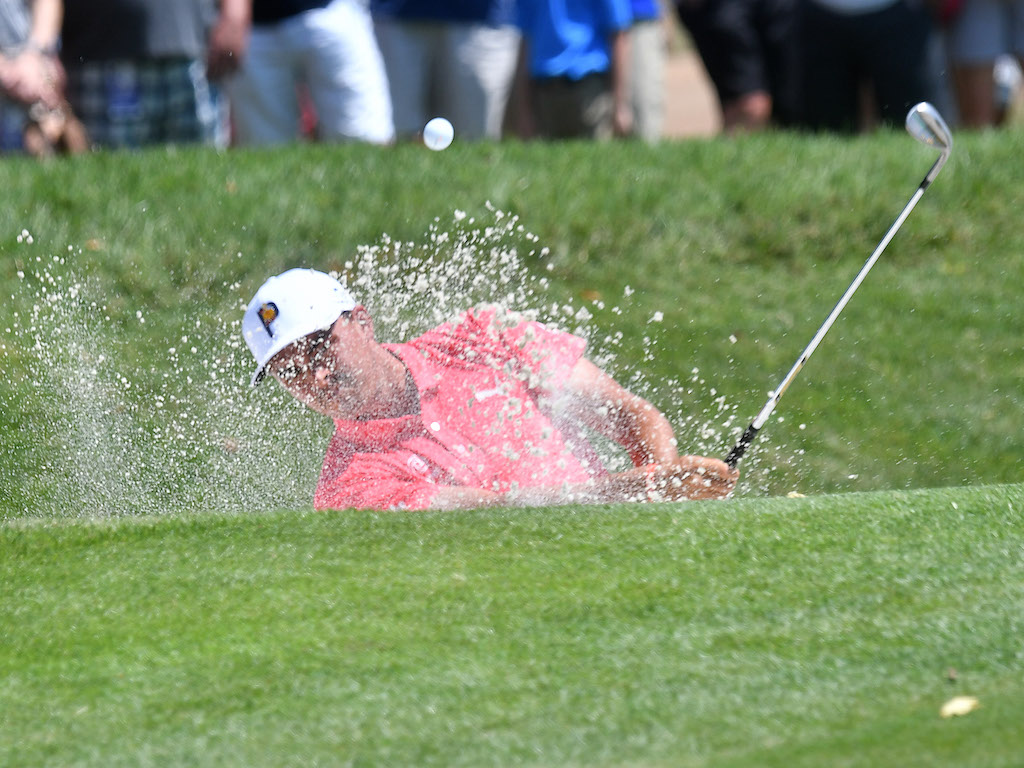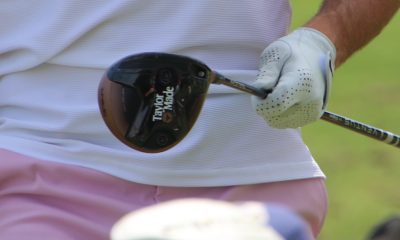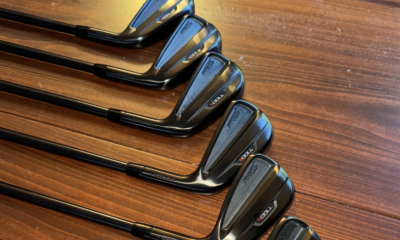Instruction
3 keys for getting out of bunkers with soft sand

One of the most infuriating things in golf is to land in a bunker that has too much sand, or sand with the consistency of a truckload of talcum power. Now, I am not picking on the Superintendents; they do have to add new sand from time-to-time, so no hate mail please! It’s my fault for hitting it in the bunker in the first place, and bunkers are supposed to be hazards; I know that.
The one thing we will assume for this article is that even though we are in soft sand, we will have a good lie, not a plugged or semi-plugged one. We are in a bunker that just has a bunch of sand, or it’s soft and fluffy sand. Everyone asks me what the secret is to handling these types of conditions and I’m here to help you get better.
1) Get a wedge with the correct bounce
Let’s consider that you play the same golf course every weekend, or that you mostly play on courses that have the same type of playing conditions mostly. When you have this luxury, you should have wedges that fit the conditions you tend to play. So, if you have a low bounce wedge with a sharp flange and you’re playing from bunkers with lots of sand, then you are putting yourself at a disadvantage.
Why alter your swing if the wedge you have can help you? Use a high bounce wedge (9-12 degrees of bounce) for soft sand, and a low bounce wedge (6-8 degrees) for firm sand.
2) Control your Angle of Attack
As with most things in golf, there are always things that you must pay attention to in order for you to have the odds in your favor. Simple things such as paying attention to the lie you have can help you save shots in the rough. In bunkers, you cannot test the surface, however, you can use your feet to feel the density of the sand. Pay attention to what you feel in the balls of your feet. If you feel a ton of sand below you, then you know you will have to alter your angle of attack if you want any chance to get out of the bunker successfully.
So what do I mean by this?
The setting of your wrists has a very dynamic effect on how much the wedge digs in or skids through the sand (assuming you have an open face). When there is a surplus of sand, you will find that a steeper attack caused by the maximum cocking of your wrists makes it much easier for the wedge to work too vertical and dig too deep. When you dig too deep, you will lose control of the ball as there is too much sand between the blade and the ball — it will not spin as much and won’t have the distance control you normally have.
The secret to playing from softer sand is a longer and wider bunker swing with much less wrist-set than you would use on your stock bunker shot. This action stops the club from digging too deep and makes it easier for you to keep moving through the ball and achieving the distance you need.
3) Keep your pivot moving
It’s nearly impossible to keep the rotation of your shoulders going when you take too much sand at impact, and the ball comes up short in that situation every time. When you take less sand, you will have a much easier time keeping your pivot moving. This is the final key to good soft-sand bunker play.
You have made your longer and more shallow backswing and are returning to the ball not quite as steeply as you normally do which is good… now the only thing left to do is keep your rear shoulder rotating through impact and beyond. This action helps you to make a fuller finish, and one that does not lose too much speed when the club impacts the sand. If you dig too deep, you cannot keep the rear shoulder moving and your shots will consistently come up short.
So if you are in a bunker with new sand, or an abundance of sand, remember to change your bounce, adjust your angle of attack, and keep your pivot moving to have a fighting chance.
- LIKE177
- LEGIT22
- WOW5
- LOL2
- IDHT0
- FLOP3
- OB4
- SHANK5
Instruction
The Wedge Guy: The easiest-to-learn golf basic

My golf learning began with this simple fact – if you don’t have a fundamentally sound hold on the golf club, it is practically impossible for your body to execute a fundamentally sound golf swing. I’m still a big believer that the golf swing is much easier to execute if you begin with the proper hold on the club.
As you might imagine, I come into contact with hundreds of golfers of all skill levels. And it is very rare to see a good player with a bad hold on the golf club. There are some exceptions, for sure, but they are very few and very far between, and they typically have beat so many balls with their poor grip that they’ve found a way to work around it.
The reality of biophysics is that the body moves only in certain ways – and the particulars of the way you hold the golf club can totally prevent a sound swing motion that allows the club to release properly through the impact zone. The wonderful thing is that anyone can learn how to put a fundamentally sound hold on the golf club, and you can practice it anywhere your hands are not otherwise engaged, like watching TV or just sitting and relaxing.
Whether you prefer an overlap, interlock or full-finger (not baseball!) grip on the club, the same fundamentals apply. Here are the major grip faults I see most often, in the order of the frequency:
Mis-aligned hands
By this I mean that the palms of the two hands are not parallel to each other. Too many golfers have a weak left hand and strong right, or vice versa. The easiest way to learn how to hold the club with your palms aligned properly is to grip a plain wooden ruler or yardstick. It forces the hands to align properly and shows you how that feels. If you grip and re-grip a yardstick several times, then grip a club, you’ll see that the learning curve is almost immediate.
The position of the grip in the upper/left hand
I also observe many golfers who have the butt of the grip too far into the heel pad of the upper hand (the left hand for right-handed players). It’s amazing how much easier it is to release the club through the ball if even 1/4-1/2″ of the butt is beyond the left heel pad. Try this yourself to see what I mean. Swing the club freely with just your left hand and notice the difference in its release from when you hold it at the end of the grip, versus gripping down even a half inch.
To help you really understand how this works, go to the range and hit shots with your five-iron gripped down a full inch to make the club the same length as your seven-iron. You will probably see an amazing shot shape difference, and likely not see as much distance loss as you would expect.
Too much lower (right) hand on the club
It seems like almost all golfers of 8-10 handicap or higher have the club too far into the palm of the lower hand, because that feels “good” if you are trying to control the path of the clubhead to the ball. But the golf swing is not an effort to hit at the ball – it is a swing of the club. The proper hold on the club has the grip underneath the pad at the base of the fingers. This will likely feel “weak” to you — like you cannot control the club like that. EXACTLY. You should not be trying to control the club with your lower/master hand.
Gripping too tightly
Nearly all golfers hold the club too tightly, which tenses up the forearms and prevents a proper release of the club through impact. In order for the club to move back and through properly, you must feel that the club is controlled by the last three fingers of the upper hand, and the middle two fingers of the lower hand. If you engage your thumbs and forefingers in “holding” the club, the result will almost always be a grip that is too tight. Try this for yourself. Hold the club in your upper hand only, and squeeze firmly with just the last three fingers, with the forefinger and thumb off the club entirely. You have good control, but your forearms are not tense. Then begin to squeeze down with your thumb and forefinger and observe the tensing of the entire forearm. This is the way we are made, so the key to preventing tenseness in the arms is to hold the club very lightly with the “pinchers” — the thumbs and forefingers.
So, those are what I believe are the four fundamentals of a good grip. Anyone can learn them in their home or office very quickly. There is no easier way to improve your ball striking consistency and add distance than giving more attention to the way you hold the golf club.
More from the Wedge Guy
- The Wedge Guy: Golf mastery begins with your wedge game
- The Wedge Guy: Why golf is 20 times harder than brain surgery
- The Wedge Guy: Musings on the golf ball rollback
- LIKE85
- LEGIT13
- WOW6
- LOL1
- IDHT0
- FLOP4
- OB1
- SHANK8
Instruction
Clement: Stop ripping off your swing with this drill!

Not the dreaded headcover under the armpit drill! As if your body is defective and can’t function by itself! Have you seen how incredible the human machine is with all the incredible feats of agility all kinds of athletes are accomplishing? You think your body is so defective (the good Lord is laughing his head off at you) that it needs a headcover tucked under the armpit so you can swing like T-Rex?
- LIKE0
- LEGIT2
- WOW2
- LOL0
- IDHT0
- FLOP0
- OB0
- SHANK2
Instruction
How a towel can fix your golf swing

This is a classic drill that has been used for decades. However, the world of marketed training aids has grown so much during that time that this simple practice has been virtually forgotten. Because why teach people how to play golf using everyday items when you can create and sell a product that reinforces the same thing? Nevertheless, I am here to give you helpful advice without running to the nearest Edwin Watts or adding something to your Amazon cart.
For the “scoring clubs,” having a solid connection between the arms and body during the swing, especially through impact, is paramount to creating long-lasting consistency. And keeping that connection throughout the swing helps rotate the shoulders more to generate more power to help you hit it farther. So, how does this drill work, and what will your game benefit from it? Well, let’s get into it.
Setup
You can use this for basic chip shots up to complete swings. I use this with every club in my bag, up to a 9 or 8-iron. It’s natural to create incrementally more separation between the arms and body as you progress up the set. So doing this with a high iron or a wood is not recommended.
While you set up to hit a ball, simply tuck the towel underneath both armpits. The length of the towel will determine how tight it will be across your chest but don’t make it so loose that it gets in the way of your vision. After both sides are tucked, make some focused swings, keeping both arms firmly connected to the body during the backswing and follow through. (Note: It’s normal to lose connection on your lead arm during your finishing pose.) When you’re ready, put a ball in the way of those swings and get to work.

Get a Better Shoulder Turn
Many of us struggle to have proper shoulder rotation in our golf swing, especially during long layoffs. Making a swing that is all arms and no shoulders is a surefire way to have less control with wedges and less distance with full swings. Notice how I can get in a similar-looking position in both 60° wedge photos. However, one is weak and uncontrollable, while the other is strong and connected. One allows me to use my larger muscles to create my swing, and one doesn’t. The follow-through is another critical point where having a good connection, as well as solid shoulder rotation, is a must. This drill is great for those who tend to have a “chicken wing” form in their lead arm, which happens when it becomes separated from the body through impact.
In full swings, getting your shoulders to rotate in your golf swing is a great way to reinforce proper weight distribution. If your swing is all arms, it’s much harder to get your weight to naturally shift to the inside part of your trail foot in the backswing. Sure, you could make the mistake of “sliding” to get weight on your back foot, but that doesn’t fix the issue. You must turn into your trial leg to generate power. Additionally, look at the difference in separation between my hands and my head in the 8-iron examples. The green picture has more separation and has my hands lower. This will help me lessen my angle of attack and make it easier to hit the inside part of the golf ball, rather than the over-the-top move that the other picture produces.


Stay Better Connected in the Backswing
When you don’t keep everything in your upper body working as one, getting to a good spot at the top of your swing is very hard to do. It would take impeccable timing along with great hand-eye coordination to hit quality shots with any sort of regularity if the arms are working separately from the body.
Notice in the red pictures of both my 60-degree wedge and 8-iron how high my hands are and the fact you can clearly see my shoulder through the gap in my arms. That has happened because the right arm, just above my elbow, has become totally disconnected from my body. That separation causes me to lift my hands as well as lose some of the extension in my left arm. This has been corrected in the green pictures by using this drill to reinforce that connection. It will also make you focus on keeping the lead arm close to your body as well. Because the moment either one loses that relationship, the towel falls.


Conclusion
I have been diligent this year in finding a few drills that target some of the issues that plague my golf game; either by simply forgetting fundamental things or by coming to terms with the faults that have bitten me my whole career. I have found that having a few drills to fall back on to reinforce certain feelings helps me find my game a little easier, and the “towel drill” is most definitely one of them.
- LIKE12
- LEGIT2
- WOW2
- LOL0
- IDHT0
- FLOP2
- OB0
- SHANK8
-

 19th Hole1 week ago
19th Hole1 week agoDave Portnoy places monstrous outright bet for the 2024 Masters
-

 19th Hole2 weeks ago
19th Hole2 weeks agoThings got heated at the Houston Open between Tony Finau and Alejandro Tosti. Here’s why
-

 19th Hole1 week ago
19th Hole1 week agoTiger Woods arrives at 2024 Masters equipped with a putter that may surprise you
-

 19th Hole2 weeks ago
19th Hole2 weeks agoReport: Tiger Woods has ‘eliminated sex’ in preparation for the 2024 Masters
-

 19th Hole4 days ago
19th Hole4 days agoTwo star names reportedly blanked Jon Rahm all week at the Masters
-

 19th Hole3 days ago
19th Hole3 days agoNeal Shipley presser ends in awkward fashion after reporter claims Tiger handed him note on 8th fairway
-

 19th Hole2 days ago
19th Hole2 days agoReport: LIV Golf identifies latest star name they hope to sign to breakaway tour
-

 19th Hole2 weeks ago
19th Hole2 weeks agoAddiction, spinal fusion, and scam artists – Everything Anthony Kim revealed in candid interview with David Feherty

























Briny Baird
Aug 16, 2018 at 7:57 am
Soft sand, swing hard.
Hard sand, swing soft.
Dave r
Aug 15, 2018 at 12:25 pm
Your just a bright ray of sunshine aren’t you . O sh t
O sh t
Aug 15, 2018 at 1:04 pm
It’s comedy
CrashTestDummy
Aug 15, 2018 at 12:32 am
One of the main issues with bunker practice is very few public courses have decent practice bunkers with good sand or any practice bunkers at all. Private courses are generally the only ones with good practice bunkers.
O sh t
Aug 15, 2018 at 3:30 am
We don’t care about them cheap muni places you play
Tom F. Stickney II
Aug 15, 2018 at 8:45 pm
O—
Find something better to do than troll a golf website. Really. Find something to do. #loser
Hogwash
Aug 16, 2018 at 10:25 am
All who use # are losers. What the heck is a hashtag, it used to be called a pound sign. Why is everything accompanied with that sign. Why can’t people just talk to each other like normal people
Tom
Aug 14, 2018 at 8:47 pm
Would you also recommend taking less sand and hitting closer to ball out of hard stuff?
Thanks for tips
Tom
Aug 14, 2018 at 12:42 pm
Can you do a similar article on hard sand? I live and play in Phoenix, and most of our bunkers are hard, with minimum sand. Thanks
Larry
Aug 14, 2018 at 2:24 pm
Just putt the ball out
Tom F. Stickney II
Aug 14, 2018 at 5:44 pm
Come in a touch more shallow with less bounce and it will work for you on the hard stuff!
O sh t
Aug 15, 2018 at 3:31 am
Just chip it out